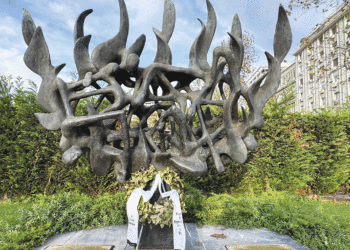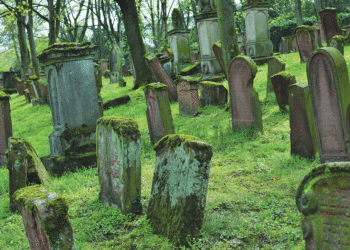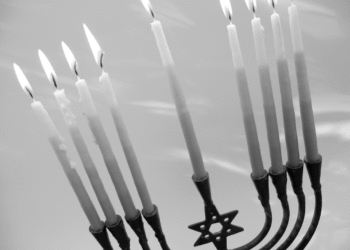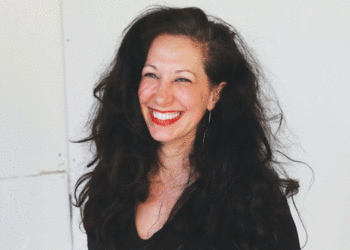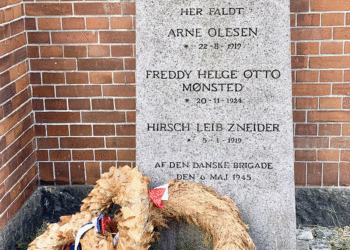Photos and story by MORDECAI SPECKTOR
Tourists throng to the Charles Bridge, which spans the Vltava River in Prague, uniting the Old Town with the Lesser Town. The famous bridge is adorned with statues. If you rub the toe of the statue of St. John of Nepomuk, you will return to Prague, according to the local lore.
And then there’s the statue of Jesus on the cross, surrounded by golden Hebrew letters: Kadosh, Kadosh, Kadosh, Adonai Tzvaot (Holy, Holy, Holy, the Lord of Hosts). What is this about? I’ve visited a lot of churches and cathedrals and seen many works of Christian art, but never have seen a crucifix with an inscription in Hebrew.
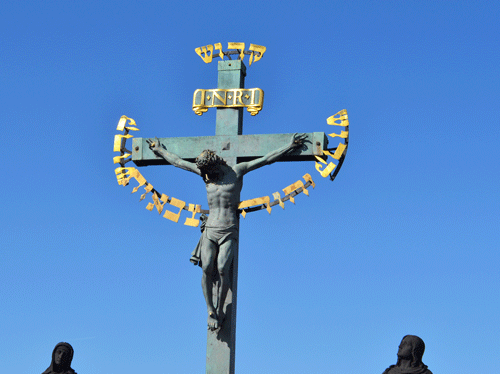
I posted a photo of the statue on my Facebook page and wondered aloud, so to speak, about what was going on. There were a number of responses, and Debra Rubin, a former editor of the Washington Jewish Week, supplied what might be the correct answer from a 2003 article in something called the Jewish Magazine (jewishmag.com).
The article written by Steven Plaut explains that, in 1696, the Prague authorities accused a Jewish leader, Elias Backoffen, of blasphemy. As punishment he was ordered to raise funds for the purchase of the Hebrew letters to adorn the statue of the crucified Jesus: “The inscription was a symbolic humiliation and degradation of Prague Jews, forcing them to pay for a set of golden letters referring to God and hung around the neck of the statue of Christ.”
A combo of Czech musicians now plays Dixieland jazz near the statue. Also, if you visit Prague, take a midnight walk on the Charles Bridge, when the tourists are gone, and enjoy the amazing views.
***
Prague is a beautiful and charming city, but somewhat overrun with tourists. In the Old Town, you have to wend your way through groups of tourists wearing headsets, listening to their tour guide delivering a lecture about the sights in view.
On one morning I set out across the Charles Bridge for a breakfast restaurant in Malá Strana, Czech for “Little Side (of the River).” After breakfast I started to roam around the neighborhood with no particular destination in mind, and came upon an imposing edifice, St. Nicholas Church.
According to the guide books, this is the most important Baroque church in Prague. It was built over the first half of the 18th century on the site of a Gothic church from the 13th century that also was dedicated to St. Nicholas. The blinged-out interior is loaded with gilded sculptures. And the peak of the main dome is an impressive 160 feet from the floor in front of the altar.
As I mentioned, I like to visit churches and cathedrals, and part of the attraction is the morbid Christian tradition of putting entire bodies and body parts on display. During a 2017 visit to Italy, we came across the odd corpse of some holy person on display in a case on the church altar or in a side chapel. (I’m not aware of a similar practice in Jewish houses of worship.)
On this point, I visited St. Stephen’s Basilica in Budapest. Named after St. Stephen I of Hungary, the first king of Hungary (975-1038 C.E.), this is said to be the most important church building in Hungary and a major tourist attraction. It’s not the most beautiful church I’ve seen; however, the mummified right hand of St. Stephen — lopped off by pagan rebels in 1061 — is housed in an ornate reliquary in the Holy Right Chapel, to the left of and behind the main altar. Known as the Holy Dexter (Szent Jobb, in Hungarian), the mummified hand is “an object of great devotion” for Hungarian Catholics, according to the Lonely Planet Pocket Budapest guide. The feast day for St. Stephen is August 20 each year; the feast day for the Holy Dexter is May 30.
***
Before jetting off to Europe, I scanned the cultural horizon in the Czech Republic and Hungary and purchased some concert tickets. The first show was at the Jazz Dock in Prague, an intimate listening room situated on a channel by the Vltava River. The cozy venue, which books prominent jazz musicians from the States and around Europe, resembles a houseboat.
On April 8, I saw Chilean singer-songwriter Camila Meza, whose music I’ve enjoyed for the past few years. As it happened, she had an all-Israeli backing band: Eden Ladin on piano, Ofri Nehemya on drums and Noam Wiesenberg on bass. Meza’s show previewed music from her upcoming album, Ambar, with The Nectar Orchestra. At the Jazz Dock, her group was augmented by the Unique Quartet, an accomplished string ensemble from Prague that played Wiesenberg’s deft arrangements. The result was an entrancing night of music.
My first night in Budapest included a visit to the Budapest Jazz Club, where Roy Hargrove, a top-notch American jazz trumpet and flugelhorn player, was booked. I’d seen Hargrove with the same group in January at the Dakota Jazz Club; but you really can’t get enough of his music. The Budapest crowd at the late show was enthusiastic and vocal; but the club has a peculiar rule: no encores. I’ll go see the band on their next visit to the Dakota.
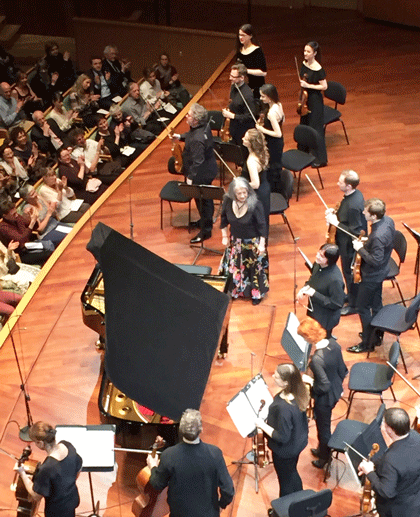
I also attended a classical concert at Bartók Béla National Concert Hall, a beautiful new auditorium in the Müpa Budapest arts complex. In Hungary, surnames come first; so the renowned composer Béla Bartók (1881-1945) is called Bartók Béla in his homeland. The house was packed April 12 to hear piano virtuoso Martha Argerich, a Jewish native of Argentina, perform with the Kremerata Baltica, a 20-piece ensemble of young string players from the Baltic countries.
Argerich played Liszt’s Piano Concerto No. 1 in E flat major. The final section of the work by the famed Hungarian composer includes some pianistic fireworks, which Argerich played to the hilt. The crowd went nuts and rewarded her and the string players with applause that went on and on. In Hungary, there’s no standing ovation; the people sit and clap, then start clapping in unison and increase the tempo. Argerich took a curtain call, then returned for a piano solo to the delight of the music lovers.
***
In Budapest, I did a series of interviews with Jewish communal officials and investigated the political drift towards authoritarian government. I wrote about this in the two previous editions of the Jewish World. I also took some time to enjoy the fine food (chicken paprikash, a traditional Hungarian burrito, etc.) and a soak in one of Budapest’s renowned thermal baths. A short tram ride took me from Pest across the Liberty Bridge to the Gellért Baths, a temple of watery pleasure that’s part of the Hotel Gellért in Buda.
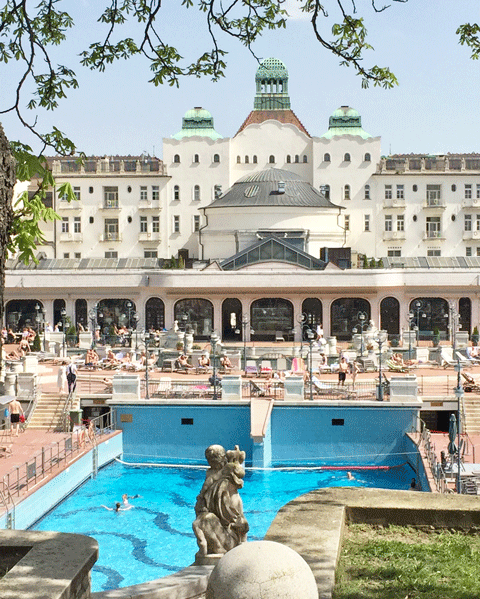
You can bring your own bathing suit, towel and sandals, or rent what you need. With your admission to the baths, a series of indoor and outdoor pools of varying temperature, you get a digital wristband that locks and unlocks your assigned locker. You also can rent a personal changing cubicle, for a fee.
When the Twin Cities was in the deep freeze, just before the mid-April blizzard, it was 80 degrees in Budapest, and I was lounging in one of the outdoor pools at the GellértBaths. Journalism is a dirty job and sometimes you have to take a bath.
***
I rented a spacious apartment with a kitchenette and washing machine — four nights for $225 through booking.com. Next door was Printa, a silk-screening shop that also sold coffee. Before I left the city, I stopped in and bought some artisanal souvenirs, including Printa’s “Illustrated Guide to Budapest’s Historical Jewish District.” The two-sided map includes descriptions of the various synagogues, schools, cafes and restaurants in the Jewish Quarter, which was the Jewish Ghetto during the Nazi occupation of Budapest.
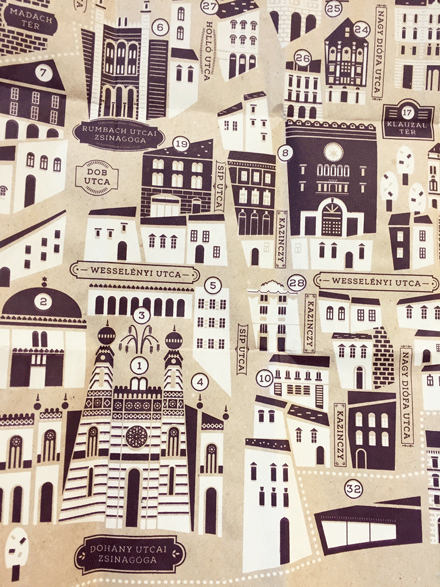
The neighborhood that once knew incomprehensible suffering is now a hip district in Budapest. On a Friday night, the streets are clogged with pedestrians and taxis. On every block a visitor finds restaurants, music bars and clubs. Near the Orthodox synagogue on Kazinczy Street, there’s Street Food Karavan, a collection of food trucks offering Hungarian specialties and all kinds of ethnic fare. I had a great meal nearby at Kőleves, which specializes in Hungarian food with a contemporary spin. The meal was delicious and very moderately priced.
It’s been nearly two months since I left Budapest, and I keep thinking about this amazing city and the wonderful people I met there.
(American Jewish World, 6.15.18)










